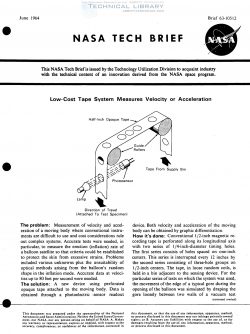NASA-BRIEF-63-10512
- Version
- 102 Downloads
- 134.25 KB File Size
- 1 File Count
- August 19, 2017 Create Date
- August 19, 2017 Last Updated
Low Cost Tape Systems Measures Velocity or Acceleration

The problem: Measurement of velocity and accel-
eration of a moving body where conventional instru-
ments are difficult to use and cost considerations rule
out complex systems. Accurate tests were needed, in
particular, to measure the erection (inflation) rate of
a balloon satellite so that criteria could be established
to protect the skin from excessive strains. Problems
included various unknowns plus the unsuitability of
optical methods arising from the balloon’s random
shape in the inflation mode. Accurate data at veloci-
ties up to 80 feet per second were needed.
The solution: A new device using perforated
opaque tape attached to the moving body. Data is
obtained through a photoelectric .sensor readout
device. Both velocity and acceleration of the moving
body can be obtained by graphic differentiation.
How it’s done: Conventional l /2-inch magnetic re-
cording tape is perforated along its longitudinal axis
with two series of l/4-inch-diameter timing holes.
The first series consists of holes spaced on one—inch
centers. This series is interrupted every 12 inches by
the second series consisting of three-hole groups on
l/2-inch centers. The tape, in loose random coils, is
held in a bin adjacent to the sensing device. For the
particular series of tests on which the system was used,
the movement of the edge of a typical gore during the
opening of the balloon was simulated by draping the
gore loosely between two walls of a vacuum test
chamber, and dropping one end of the gore.
The motion of the falling end simulated the opening
motion satisfactorily, and, by affixing the free end of
the tape to the falling end, its acceleration and
velocity were measured. The measurement was made
by allowing the tape to be freely paid out and passing
it betweenva light source and a photoelectric sensor.
The output from the photosensor was fed to a suitable
readout device and displayed in the form of alcon-
ventional inked plot on a travelling paper graph.
Opening velocities (as high as 80 feet per second)
of a satellite balloon in a vacuum environment have
been recorded with consistently high accuracy. Rela-
tive velocity and acceleration have been determined
for each drop. In one of the tests, the instrument
revealed the unexpected occurrence of several velocity
fluctuations at the end of the drop, or opening
mode of the satellite balloon.
| File | Action |
|---|---|
| NASA-BRIEF-63-10512 Low Cost Tape Systems Measures Velocity or Acceleration.pdf | Download |

Comment On This Post